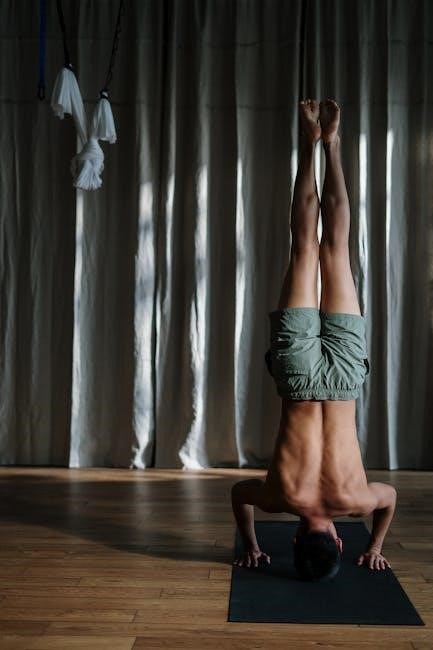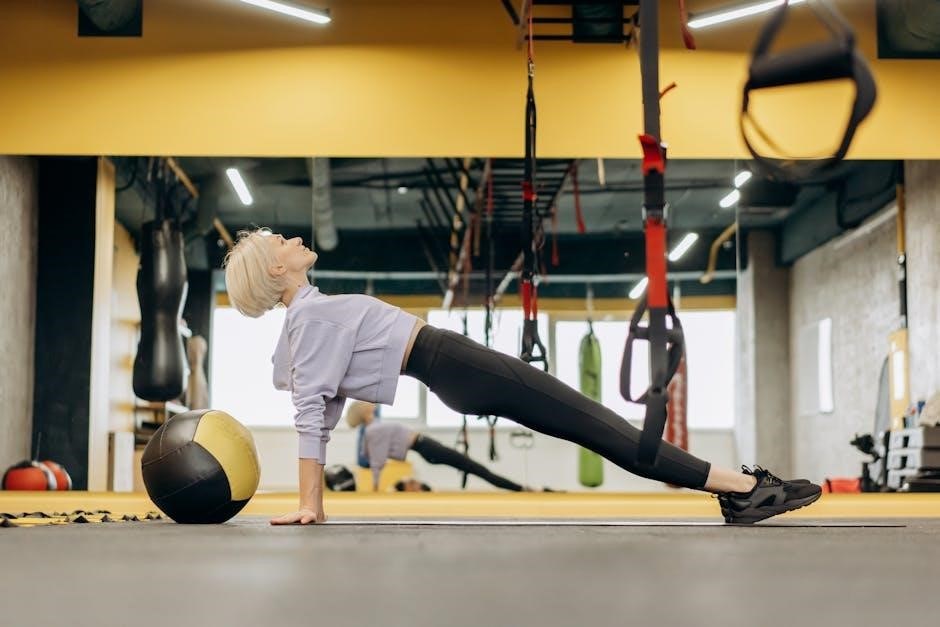Core stabilization exercises are essential for improving posture, balance, and body stability․ They target the muscles of the trunk, enhancing strength and reducing injury risk․
What Are Core Stabilization Exercises?
Core stabilization exercises are specialized movements designed to enhance the strength and control of the trunk muscles, including the abdominals and lower back․ These exercises focus on activating the deep stabilizing muscles, such as the transverse abdominis, to improve spinal stability and overall body alignment․ They often involve isometric holds or controlled movements, like planks or bird-dog exercises, which require minimal equipment and emphasize proper form․ The goal is to create a stable base for the body, reducing the risk of injury and improving posture․ These exercises are particularly beneficial for individuals with back pain or those seeking to enhance athletic performance by building a stronger, more resilient core․
Why Core Stabilization Is Important
Core stabilization is crucial for maintaining proper posture, balance, and overall physical stability․ It enhances the body’s ability to distribute mechanical loads effectively, reducing the risk of injuries, particularly in the lower back; Strong core stabilization improves athletic performance by providing a stable base for movements, allowing for more efficient power transfer and better coordination․ Additionally, it aids in everyday activities by supporting the spine and pelvis, reducing strain on muscles, and promoting better alignment․ A stable core also enhances proprioception, the body’s awareness of its position and movement, which is vital for maintaining balance and preventing falls․ Regular practice of core stabilization exercises contributes to long-term musculoskeletal health and overall well-being․

Understanding Core Stabilization
Core stabilization involves the trunk muscles working together to support the spine and pelvis, providing a stable base for movement and reducing injury risk․
The Core Muscles Involved
The core muscles include the transverse abdominis, obliques, rectus abdominis, erector spinae, and diaphragm․ These muscles work together to stabilize the spine and pelvis, providing a solid foundation for movement․ The transverse abdominis acts as the body’s natural corset, wrapping around the spine to enhance stability․ The obliques assist in rotational movements, while the rectus abdominis supports pelvic alignment․ The erector spinae maintains posture, and the diaphragm plays a role in breathing and core activation․ Strengthening these muscles through stabilization exercises improves overall stability, posture, and reduces the risk of injury, making them essential for both daily activities and athletic performance․
Key Principles of Core Stabilization
Core stabilization relies on proper muscle activation, control, and alignment․ Maintaining pelvic neutrality and spinal stability is crucial during exercises․ Controlled breathing enhances core engagement, while slow, precise movements prevent injury․ Proper form ensures targeting the right muscles, and gradual progression builds strength safely․ Consistency and focus on technique yield the best results, making these principles foundational for effective core stabilization․

Types of Core Stabilization Exercises
Core stabilization exercises include isometric and dynamic movements․ Isometric exercises, like planks, involve holding positions, while dynamic exercises, such as bird dogs, incorporate controlled movements to enhance stability․
Isometric Core Stabilization Exercises
Isometric core stabilization exercises involve holding static positions to strengthen the muscles without movement․ Planks, bird dogs, and Superman holds are popular examples․ These exercises enhance endurance, posture, and spinal stability by engaging the transverse abdominis and obliques․ They are low-impact, reducing injury risk, and improve muscle activation․ Regular practice boosts athletic performance and daily activities by providing a strong, stable base․ Incorporating isometric exercises into routines is effective for all fitness levels, promoting overall core resilience and functional strength․
Dynamic Core Stabilization Exercises
Dynamic core stabilization exercises involve controlled movements that challenge the core muscles to maintain stability․ Examples include bird dogs, side bridges, and Pallof presses; These exercises improve balance, coordination, and functional strength by engaging the entire core during motion․ They are particularly beneficial for athletes, as they mimic real-world movements and enhance performance․ Dynamic exercises also promote better posture and reduce injury risk by strengthening the muscles around the spine․ Progressions can include adding resistance or increasing movement complexity․ Regular practice improves stability during daily activities and sports, making these exercises versatile for all fitness levels․ They are essential for building a resilient and adaptable core․

Benefits of Core Stabilization Exercises
Core stabilization exercises enhance posture, balance, and overall stability․ They strengthen trunk muscles, reducing back pain and improving athletic performance․ Regular practice boosts resilience and daily function․
Improved Posture and Balance
Core stabilization exercises significantly enhance posture and balance by strengthening the muscles that support the spine and pelvis․ These exercises, such as planks and bird-dog exercises, target the transverse abdominis, obliques, and lower back muscles, which are essential for maintaining a neutral spine alignment․ Improved core stability ensures better distribution of force across the body, reducing strain on the spine and joints․ This leads to better posture, as the body naturally aligns in a more efficient position․ Additionally, a stable core provides a solid foundation for movement, enhancing balance and coordination, which are critical for daily activities and reducing the risk of falls or injuries․

Injury Prevention and Rehabilitation
Core stabilization exercises play a crucial role in injury prevention and rehabilitation by strengthening the muscles that support the spine and pelvis․ These exercises, such as planks and bird-dog exercises, enhance spinal stability and reduce the risk of lower back pain and other injuries․ For individuals recovering from injuries, core stabilization exercises are often prescribed to rebuild strength and improve mobility․ They help restore proper muscle activation patterns, which are essential for preventing re-injury․ By focusing on controlled movements and proper form, these exercises promote healing and resilience, making them a cornerstone of rehabilitation programs for athletes and individuals with back conditions alike․

Core Stabilization Exercise Progression
Progression involves increasing hold times and repetitions as strength improves, moving through levels from basic to advanced exercises to build stability and resilience over time․
Beginner Exercises
Beginner core stabilization exercises focus on building foundational strength and awareness․ Start with isometric holds like planks, bird dogs, and pelvic tilts․ These exercises teach proper activation of core muscles without movement․ Gradually introduce gentle movements, such as bridging or leg lifts, while maintaining a neutral spine․ Breathing techniques are crucial; exhale during exertion to engage the transverse abdominis․ Perform 2-3 sets of 10-15 reps, ensuring form remains consistent․ These exercises lay the groundwork for more advanced routines, improving posture and reducing the risk of injury․ Consistency and proper form are key to progressing effectively․
Intermediate Exercises
Intermediate core stabilization exercises introduce dynamic movements while maintaining control․ Examples include side planks with leg lifts and stability ball exercises like rollouts or crunches․ These exercises challenge the core by adding resistance or movement, enhancing both strength and endurance․ Incorporate anti-rotation drills, such as cable rotations or pallof presses, to improve functional stability․ Dynamic planks, like shoulder taps or knee drives, also elevate the difficulty․ Perform 3 sets of 12-15 reps, focusing on controlled movements and proper breathing․ These exercises build upon foundational strength, preparing the body for more complex movements and real-world applications, ensuring a balanced and resilient core․
Advanced Exercises
Advanced core stabilization exercises challenge the body with complex movements and increased intensity․ These include single-arm or single-leg exercises on a stability ball, such as rollouts or jackknives, which require precision and control․ Dynamic exercises like medicine ball throws or rotational tosses enhance power and stability․ Incorporate advanced anti-rotation drills, such as weighted cable rotations or offset loading, to test core resilience․ For experienced individuals, exercises like dragon flags or hanging leg raises can target the entire core with minimal equipment․ Perform 3-4 sets of 8-12 reps, emphasizing explosive power and maintenance of neutral spine․ These exercises are ideal for athletes or those seeking to maximize core strength and functional performance, ensuring peak stability and efficiency in high-demand activities․

Creating a Core Stabilization Routine
A well-structured core routine begins with foundational exercises, progresses gradually, and incorporates variety to maintain engagement and effectiveness․ Consistency and proper form are key to achieving lasting results․
How to Structure a Workout
Structuring a core stabilization workout involves starting with a warm-up to prepare the muscles․ Begin with foundational exercises like planks and bird dogs to establish stability․ Progress to dynamic movements such as dead bugs or side bridges to challenge the core further․ Incorporate isometric holds for strength and endurance․ Use a circuit format, completing one set of each exercise before moving to the next, with brief rest periods between sets․ Aim for 3-4 sets of 10-15 repetitions for each exercise․ Finish with stretching to improve flexibility and reduce muscle tension․ Adjust intensity and duration based on fitness level and goals․
Incorporating Variety
Incorporating variety into your core stabilization routine keeps workouts engaging and ensures comprehensive muscle development․ Alternate between isometric exercises like planks and dynamic movements such as dead bugs or side bridges․ Utilize equipment like exercise balls or resistance bands to add challenge and diversity․ Include rotational exercises to target obliques and improve functional strength․ Vary the duration of holds, repetitions, and resistance levels to keep the workouts progressive․ Mixing unilateral and bilateral exercises can also enhance balance and symmetry․ Regularly changing the sequence of exercises prevents plateaus and ensures continuous improvement in core stability and overall strength․

Core Stabilization Exercises for Specific Needs
Core stabilization exercises can be tailored to address specific needs, such as lower back pain or athletic performance, offering structured programs to enhance strength and resilience․
Exercises for Lower Back Pain

Core stabilization exercises are highly effective for alleviating lower back pain by strengthening the muscles that support the spine․ Key exercises include Dead Bugs, which target the transverse abdominis, and Bird Dogs, which improve posture and balance․ Plank variations also enhance spinal stability․ These exercises focus on activating the deep core muscles, such as the transverse abdominis, to provide a natural brace for the spine․ Regular practice helps reduce back pain by improving posture and preventing muscle imbalances; Proper form is essential to avoid exacerbating injuries․ Incorporating these exercises into a daily routine can significantly improve lower back health and overall stability․
Exercises for Athletes
Core stabilization exercises are crucial for athletes to enhance performance and prevent injuries․ Dynamic exercises like rotational movements and single-arm planks improve stability and balance․ Medicine ball throws and lateral walks with resistance bands strengthen the obliques and enhance power․ These exercises mimic sport-specific movements, boosting functional strength․ Incorporating core stabilization into training routines helps athletes maintain optimal posture and generate force efficiently․ Regular practice reduces the risk of injuries, particularly in high-impact sports․ Strengthening the core muscles also improves endurance and agility, giving athletes a competitive edge․ Tailored core workouts ensure athletes meet the demands of their sport while maintaining peak physical condition․

Common Mistakes to Avoid
Incorrect form, failure to activate core muscles, and overtraining are common mistakes․ These can lead to muscle strain or ineffective workouts, reducing exercise benefits․
Incorrect Form and Activation
One of the most frequent errors in core stabilization exercises is improper form and insufficient activation of the core muscles․ Many individuals fail to engage their transverse abdominis, relying instead on secondary muscles, which can lead to poor movement patterns and reduced effectiveness․ For example, during planks, allowing the hips to sag or the back to arch can put unnecessary strain on the lower back․ Similarly, in exercises like dead bugs, not maintaining a neutral pelvic position can diminish the exercise’s effectiveness and increase the risk of injury․ Proper activation involves drawing the belly button towards the spine and maintaining a stable pelvis throughout the movement․ This ensures that the core muscles function as intended, providing the necessary support and stability․ Without correct form and activation, the benefits of core exercises are significantly diminished, and the risk of injury is elevated․
Overtraining the Core
Overtraining the core can lead to muscle fatigue, poor form, and increased injury risk․ Performing excessive sets or repetitions without proper rest can strain the muscles, reducing their effectiveness․ For example, overdoing plank variations or dynamic exercises without progression can cause unnecessary stress on the lower back․ It’s important to balance core workouts with adequate recovery to avoid muscle imbalances․ Gradual progression and focusing on quality over quantity ensure sustainable growth and injury prevention․ Always prioritize proper form and listen to your body to maintain a safe and effective training routine․
Core stabilization exercises are vital for enhancing strength, posture, and overall stability․ Consistent practice improves balance and reduces injury risk, promoting long-term physical well-being and resilience․
Final Thoughts on Core Stabilization
Core stabilization exercises are a cornerstone of fitness, promoting strength, balance, and injury prevention․ By targeting the trunk muscles, these exercises enhance posture, reduce back pain, and improve overall stability․ They are adaptable to all fitness levels, ensuring progress and long-term benefits․ Regular practice fosters resilience, supporting daily activities and athletic performance․ Emphasizing proper form and consistency is key to maximizing results․ A strong, stable core not only boosts physical performance but also contributes to mental confidence and well-being․ Incorporating these exercises into your routine is a simple yet powerful step toward achieving a healthier, more active lifestyle․ Consistency is the foundation of success in core stabilization․
